- Reader view

Tourist Traffic Act , 1957
(Act 27 of 1957) Tourist Traffic Bill, 1957 (Bill 27 of 1957)
Last updated: 17 Dec 1957
Sponsored by: Minister for Industry and Commerce
Source: Government
Originating House: Dáil Éireann
History of this Act
The Bill has been signed into law by the President.
17 Dec 1957
Dáil Éireann
Seanad Éireann
Dáil First Stage
The Bill is initiated or presented to the House
Dáil Second Stage
The general principles of the Bill are debated
Dáil Third Stage
The Bill is examined section by section and amendments may be made (Also known as Committee Stage)
Dáil Fourth Stage
Amendments arising out of Committee Stage are considered (Also known as Report Stage)
Dáil Fifth Stage
Final statements on the Bill are made and it is set down for Second Stage in the Seanad (Also known as Final Stage)
Seanad First Stage
The Bill is deemed to have passed Seanad First Stage
Seanad Second Stage
11 Dec 1957
Seanad Third Stage
Seanad fourth stage, seanad fifth stage.
Final statements on the Bill are made (Also known as Final Stage)
The Bill is signed into law by the President
- Act and Bill text
As Passed by both Houses of the Oireachtas
Tourist Traffic Bill, 1957
As amended in Committee/Select Committee (Dáil Eireann)
As initiated
This list of debates may not be complete. You can also search directly for this Bill within the Debates section.
Tourist Traffic Bill, 1957—Second and Subsequent Stages.
Committee on Finance. - Tourist Traffic Bill, 1957—Report and Final Stages.
Committee on Finance. - Tourist Traffic Bill, 1957—Committee Stage.
Committee on Finance. - Tourist Traffic Bill, 1957—Money Resolution.
21 Nov 1957
Tourist Traffic Bill, 1957—Second Stage (Resumed).
Tourist Traffic Bill, 1957—Second Stage.
Tourist Traffic Bill, 1957—First Stage.

- Apps & Integrations
- Legislation
Tourist traffic act, 1957
Number 27 of 1957.
TOURIST TRAFFIC ACT, 1957.
AN ACT TO AMEND THE TOURIST TRAFFIC ACTS, 1939 TO 1955. [17 th December , 1957.]
BE IT ENACTED BY THE OIREACHTAS AS FOLLOWS:—
Construction.
1. —(1) In this Act—
“the Act of 1939” means the Tourist Traffic Act, 1939 (No. 24 of 1939);
“the Act of 1952” means the Tourist Traffic Act, 1952 (No. 15 of 1952);
“the Board” means Bord Fáilte Éireann;
“the Minister” means the Minister for Industry and Commerce.
(2) The Tourist Traffic Acts, 1939 to 1955, and this Act shall be construed as one.
Extension of time limit on giving of guarantees under Part III of Act of 1952.
2. —(1) section 21 of the Act of 1952 (which relates to the time limit on the giving of guarantees under Part III of that Act) is hereby amended by the substitution of “ten years from the passing of this Act” for “five years from the passing of this Act”.
(2) Subsection (1) of this section shall be deemed to have come into operation on the 3rd day of July, 1957, and, accordingly, anything which was effected on or after that day and before the passing of this Act and which purported to be in pursuance of any provision contained in Part III of the Act of 1952 shall be deemed to be and always to have been valid and proper and shall be regarded as having been effected in pursuance of that provision.
Grants by the Board for interest charges on certain loans.
3. —(1) The Board may, at its discretion, make grants towards the payment of interest on loans obtained after the passing of this Act otherwise than under a guarantee given under Part III of the Act of 1952 and utilised for the construction, extension, modernisation or improvement of holiday accommodation.
(2) The aggregate amount of grants made by the Board under this section in any financial year shall not, when added to the aggregate amount of grants made by the Board under Part III of the Act of 1952 in that year, exceed seventy-five thousand pounds.
Grants to local authorities and local development companies.
4. —Paragraph ( c ) of subsection (2) of section 5 (which relates to the functions of the Board) of the Act of 1952 shall be construed as enabling the Board to make grants for the purposes mentioned in that paragraph to—
( a ) local authorities, and
( b ) companies formed under the Companies Acts, 1908 to 1924, having the object of providing amenities and facilities at tourist resorts and developing tourist traffic at or to such resorts.
Motor hotels.
5. —(1) The Act of 1939 is hereby amended as follows:
(i) by the addition to subsection (1) of section 24 (which relates to the registers to be maintained by the Board) of the following paragraph:
“( f ) a register to be called and known and in this Act referred to as the register of motor hotels.”;
(ii) by the addition to section 25 (which relates to the eligibility of premises for registration) of the following paragraph:
“( f ) the general character, the type of accommodation and service provided, and the other qualifications which shall be requisite in respect of any premises in order that such premises may be eligible for registration in the register of motor hotels.”;
(iii) by the insertion after section 37 of the following section:
“37A.—(1) It shall not be lawful for the proprietor or occupier of any premises to describe or hold out or permit any person to describe or hold out such premises—
( a ) as a motor hotel,
( b ) as a motel,
( c ) as a coach hotel,
( d ) as a motor inn,
( e ) as a motor court,
( f ) as a tourist court, or
( g ) as being of any other description prescribed for the purposes of this section,
unless such premises are registered in the register of motor hotels and such proprietor or occupier is registered in that register as the registered proprietor of such premises.
(2) Any person who acts in contravention of this section shall be guilty of an offence and shall be liable on summary conviction thereof to a fine not exceeding fifty pounds together with, in the case of a continuing offence, a further fine not exceeding two pounds for every...
To continue reading
Subscribers can access the reported version of this case.
You can sign up for a trial and make the most of our service including these benefits.

Why Sign-up to vLex?
Over 100 countries.
Search over 120 million documents from over 100 countries including primary and secondary collections of legislation, case law, regulations, practical law, news, forms and contracts, books, journals, and more.
Thousands of Data Sources
Updated daily, vLex brings together legal information from over 750 publishing partners, providing access to over 2,500 legal and news sources from the world’s leading publishers.
Find What You Need, Quickly
Advanced A.I. technology developed exclusively by vLex editorially enriches legal information to make it accessible, with instant translation into 14 languages for enhanced discoverability and comparative research.
Over 2 million registered users
Founded over 20 years ago, vLex provides a first-class and comprehensive service for lawyers, law firms, government departments, and law schools around the world.
Subscribers are able to see a list of all the cited cases and legislation of a document.
Subscribers are able to see a list of all the documents that have cited the case.
Subscribers are able to see the revised versions of legislation with amendments.
Subscribers are able to see any amendments made to the case.
Subscribers are able to see a visualisation of a case and its relationships to other cases. An alternative to lists of cases, the Precedent Map makes it easier to establish which ones may be of most relevance to your research and prioritise further reading. You also get a useful overview of how the case was received.

Subscribers are able to see the list of results connected to your document through the topics and citations Vincent found.
VLEX uses login cookies to provide you with a better browsing experience. If you click on 'Accept' or continue browsing this site we consider that you accept our cookie policy . ACCEPT

- Séanadh
- Deasc chabhrach
- Gaeilge English
Produced by the Office of the Attorney General
Táirgthe ag Oifig an Ard-Aighne
- Acts of the Oireachtas
- Statutory Instruments
- Pre-1922 Legislation
- Constitution
- Bills (Houses of the Oireachtas)
- Iris Oifigiúil / Official Gazette
- Revised Acts (LRC)
- Classified List of Legislation (LRC)
- Translations (acts.ie)
- Translations (Houses of the Oireachtas)
- Government Publications for Sale
- EU Law (EUR-Lex)
- Achtanna an Oireachtais
- Ionstraimí Reachtúla
- Reachtaíocht Réamh-1922
- Billí (Tithe an Oireachtais)
- Iris Oifigiúil
- Achtanna Athbhreithnithe (CAD) (An Coimisiún um Athchóiriú an Dlí)
- Liosta Rangaithe Reachtaíochta
- Aistriúcháin (achtanna.ie)
- Aistriúcháin (Tithe an Oireachtais)
- Foilseacháin Rialtais ar Díol
- Dlí AE (EUR-Lex)
- CCanna (Ceisteanna Coitianta)
- Acts Achtanna
- Tourist Traffic Act, 1957
Tourist Traffic Act, 1957 Permanent Page URL
- View by Section Amharc de réir Ailt
- View Full Act Amharc ar an Acht Iomlán
- Bill History Stair Bille
- Commencement, Amendments, SIs made under the Act Tosach Feidhme, Leasuithe, IRí arna ndéanamh faoin Acht
- Revised Act Acht Athbh
- Print Full Act Priontáil an tAcht Iomlán
- Previous Section Alt Roimhe
- Next Section An Chéad Alt Eile
- Print Section Priontáil an tAlt
- Bahasa Indonesia
- Slovenščina
- Science & Tech
- Russian Kitchen
What were foreign tourists allowed to see on trips to the Soviet Union?
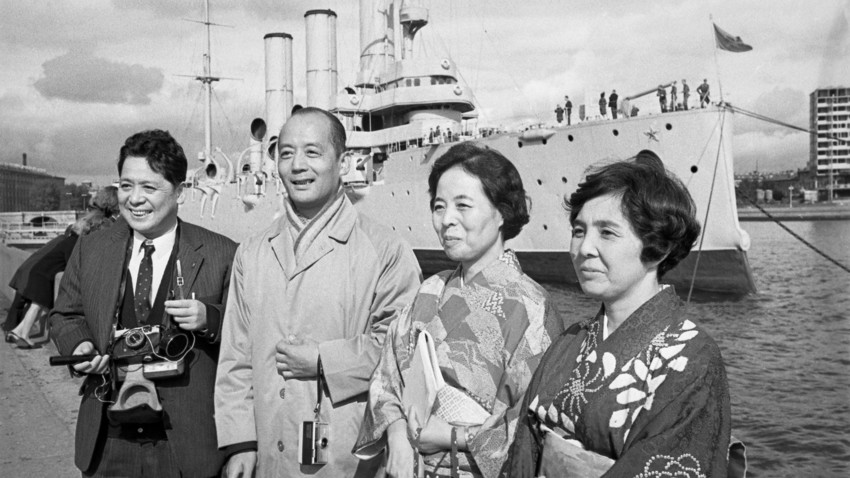
Japanese tourists with the Avrora cruiser in the background. Leningrad, 1968
Although the Soviet Union was rather closed off to outsiders, it was still possible to go there. For many foreigners, such a trip was an expensive luxury, but one that gave them the experience of a lifetime.
It is not just a trip, it is a trip into a new world
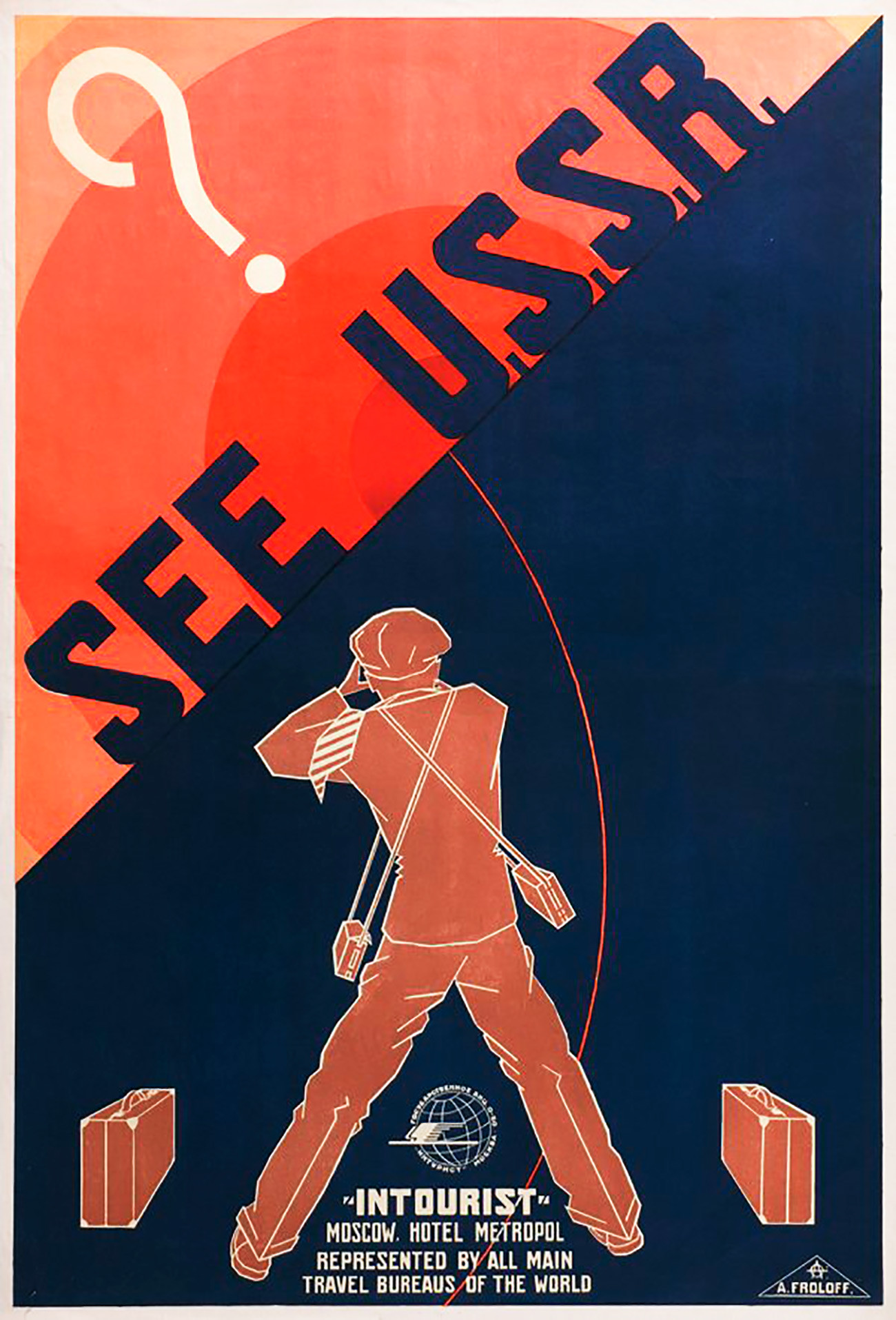
Intourist poster
Soon after the Soviet Union was established, its leadership began thinking about how to attract foreign tourists since the country's economy was in desperate of foreign currency. In 1929, the state joint-stock company Intourist was created and given a monopoly on the sale of tours to the USSR. One of its slogans was: "It is not just a trip, it is a trip into a new world." Foreign tourists were intrigued.

Intourist poster, 1930
Some of the first foreigners to visit the Soviet Union were famous writers, artists and other public figures. Theodore Dreiser came in 1927, Bernard Shaw in 1932 and French writer and Nobel Prize winner Romain Rolland in 1935.
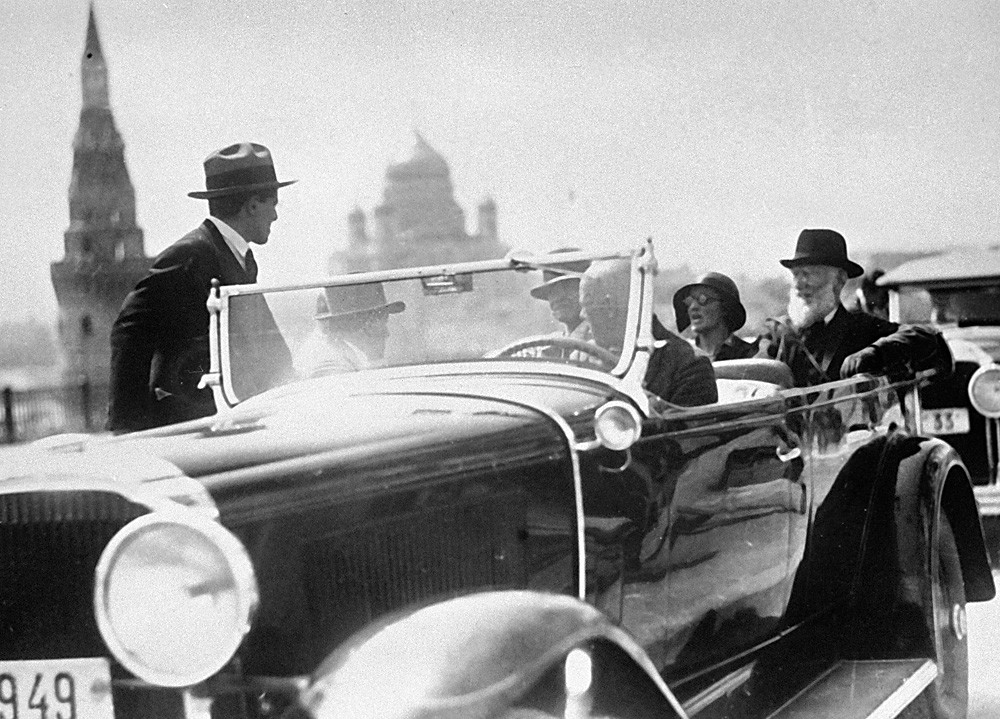
Bernard Shaw in Moscow, 1931
In the 1930s, Intourist opened offices in the United Kingdom, Germany, and the United States. Before the start of World War II, some 129,000 foreign tourists visited the USSR. They were offered different itineraries throughout the country, from Moscow to the Russian Far East. Tourists were lured by posters like these, which were created by the best Soviet illustrators.
In addition to Moscow and Leningrad, other major attractions included Crimea, Volga cruises and road trips across the country.
The flow of tourists to the USSR resumed after the war, and in the 1950s the country entered a period of political “thaw.” The Soviet leader Nikita Khrushchev began travelling around the world, and the Soviet Union began hosting international events like the world festival of youth and students. In total, more than 70 million tourists from 162 countries visited the USSR between 1956 and 1985.
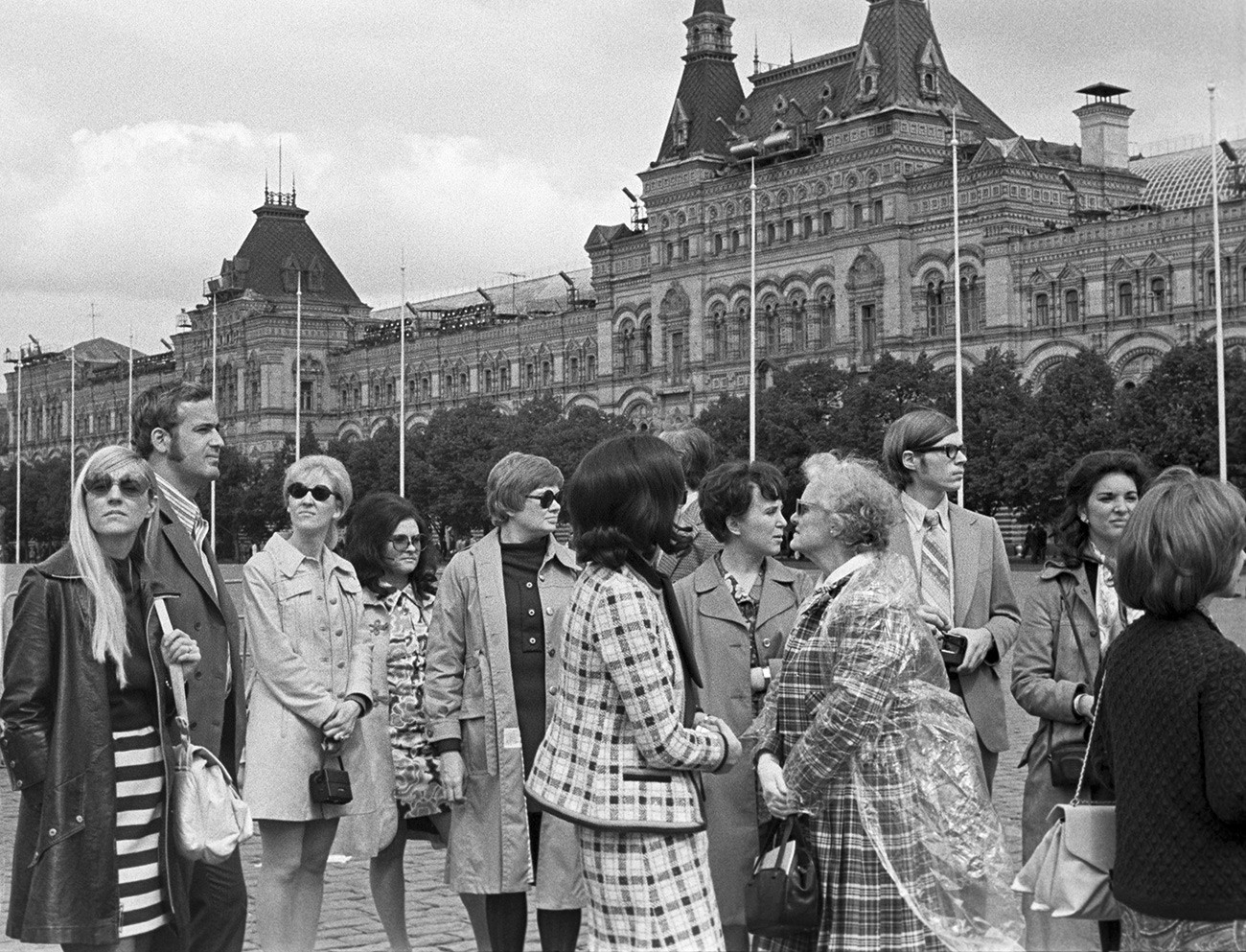
American tourists in Moscow, 1972
But at the same time no one was going to let foreigners wander around on their own. The country could only be explored under the watchful eye of an Intourist guide/translator. Any private plans had to be abandoned, and foreign tourists were only shown ideologically impeccable achievements of the Soviet economy and lifestyle.
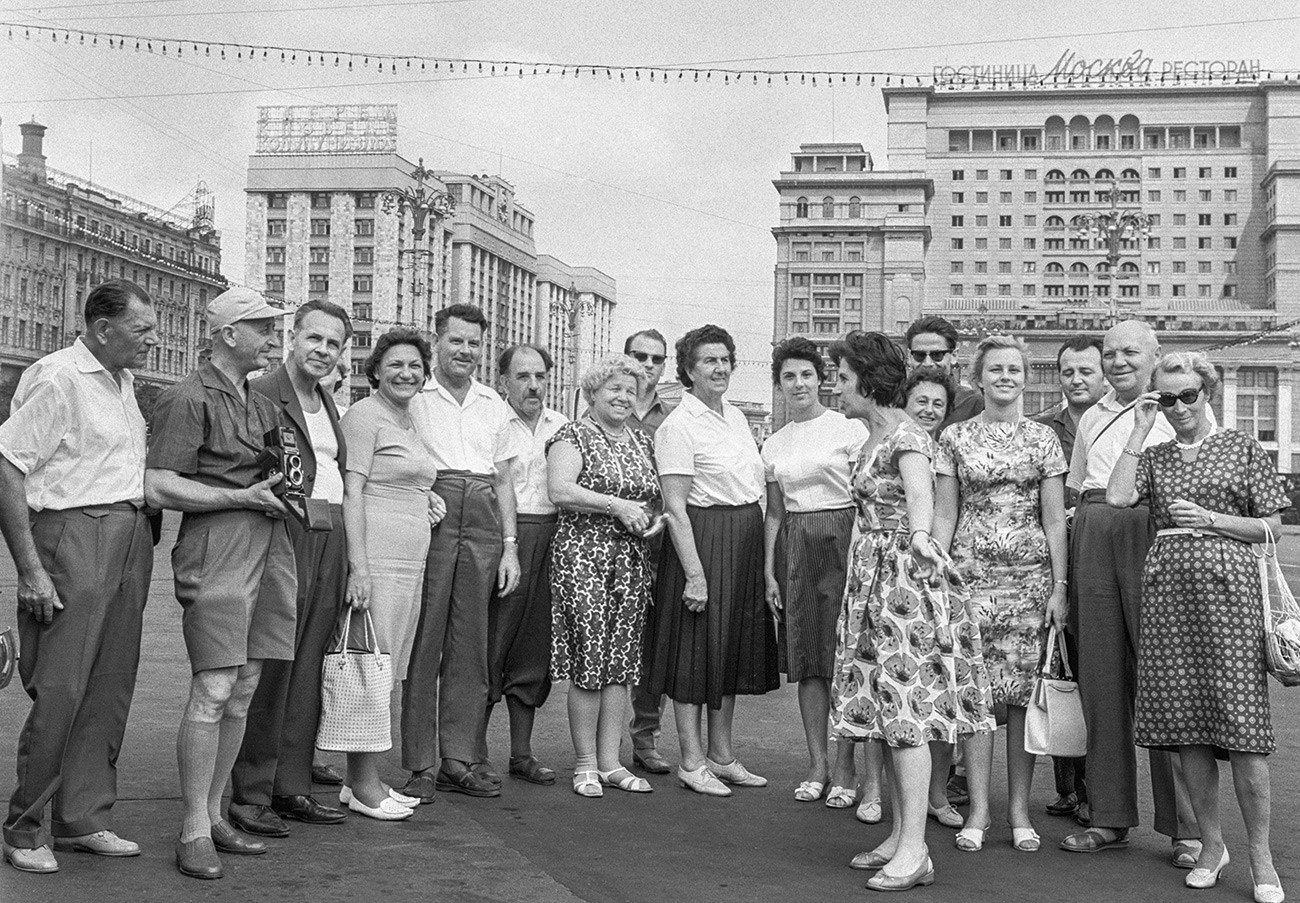
Tourists from Austria in Manezhnaya Square, 1963
The science fiction writer Robert Heinlein and his wife Virginia visited the USSR with an Intourist group in 1959-1960. Afterwards he wrote about the all-encompassing control the guides exercised on their group, an extortionate exchange rate (4 rubles to a dollar) and glaring gaps between customer service in the USA and the USSR.
["I cannot honestly urge anything short of ‘Luxe’ class because even the best in Russia is often shockingly bad by our standards—bathrooms without baths, even hotels with no baths, tubs with no hot water, plumbing that is 'quaint' or worse, poor cooking, dirty utensils, maddening waits," Heinlein wrote in an article titled Inside Intourist .

A souvenir shop 'Berezka' at the Intourist hotel. 1983
Heinlein’s wife even studied Russian to prepare for the trip, but this turned out to be useless because they were “prisoners of Intourist, seeing only what they want you to see, hearing only what they want you to hear.” Heinlein calculated that for an ordinary American, a trip to see socialism in action in the USSR was extremely expensive—around $4,500 per month.
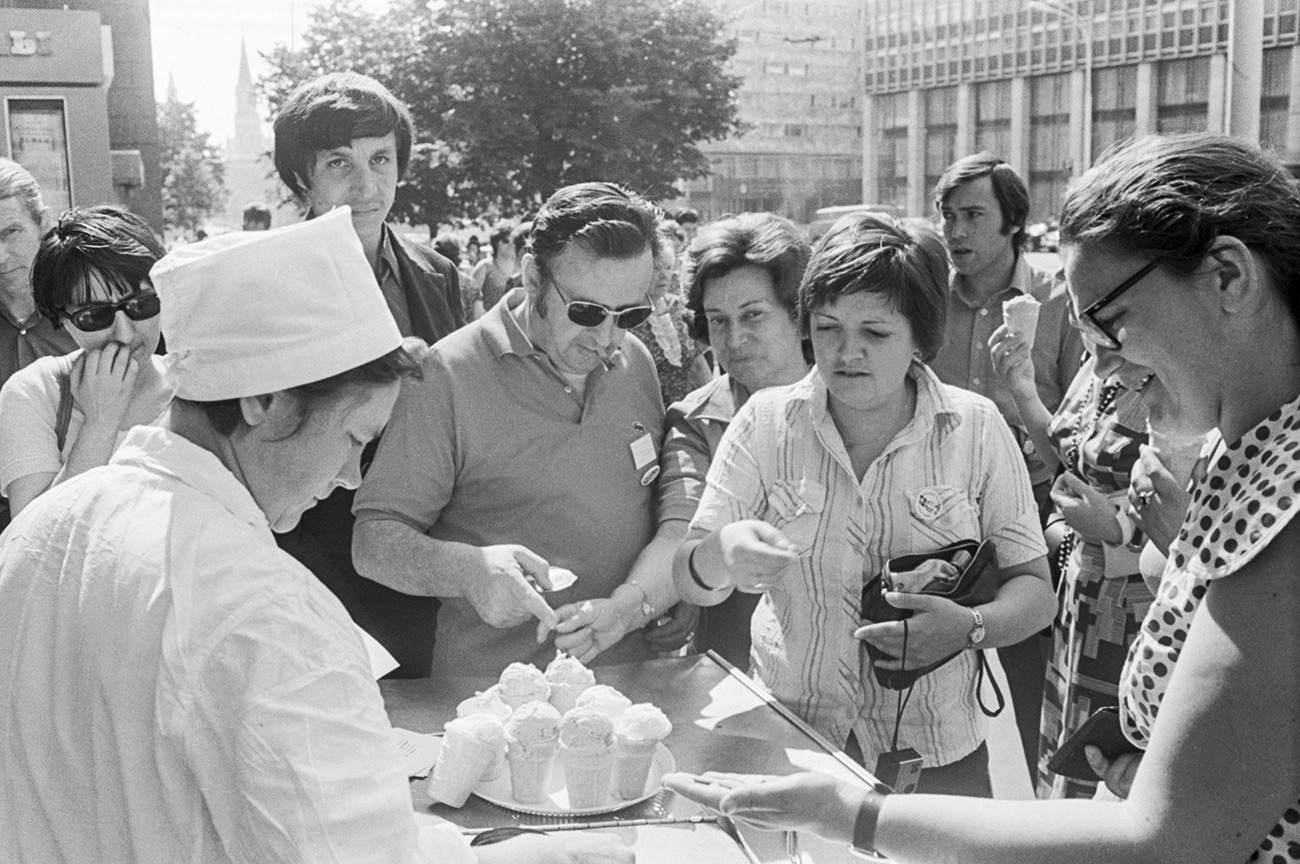
Tourists from France tasting Moscow ice-cream 1976
A guide must be politically well versed
Choosing the right people to work for Intourist was not an easy task. Guides had to have a university degree in linguistics and speak several languages, but in addition to this they had also to know what they could and could not talk about. A big part of this role was being able to competently point out the achievements of the Soviet system.
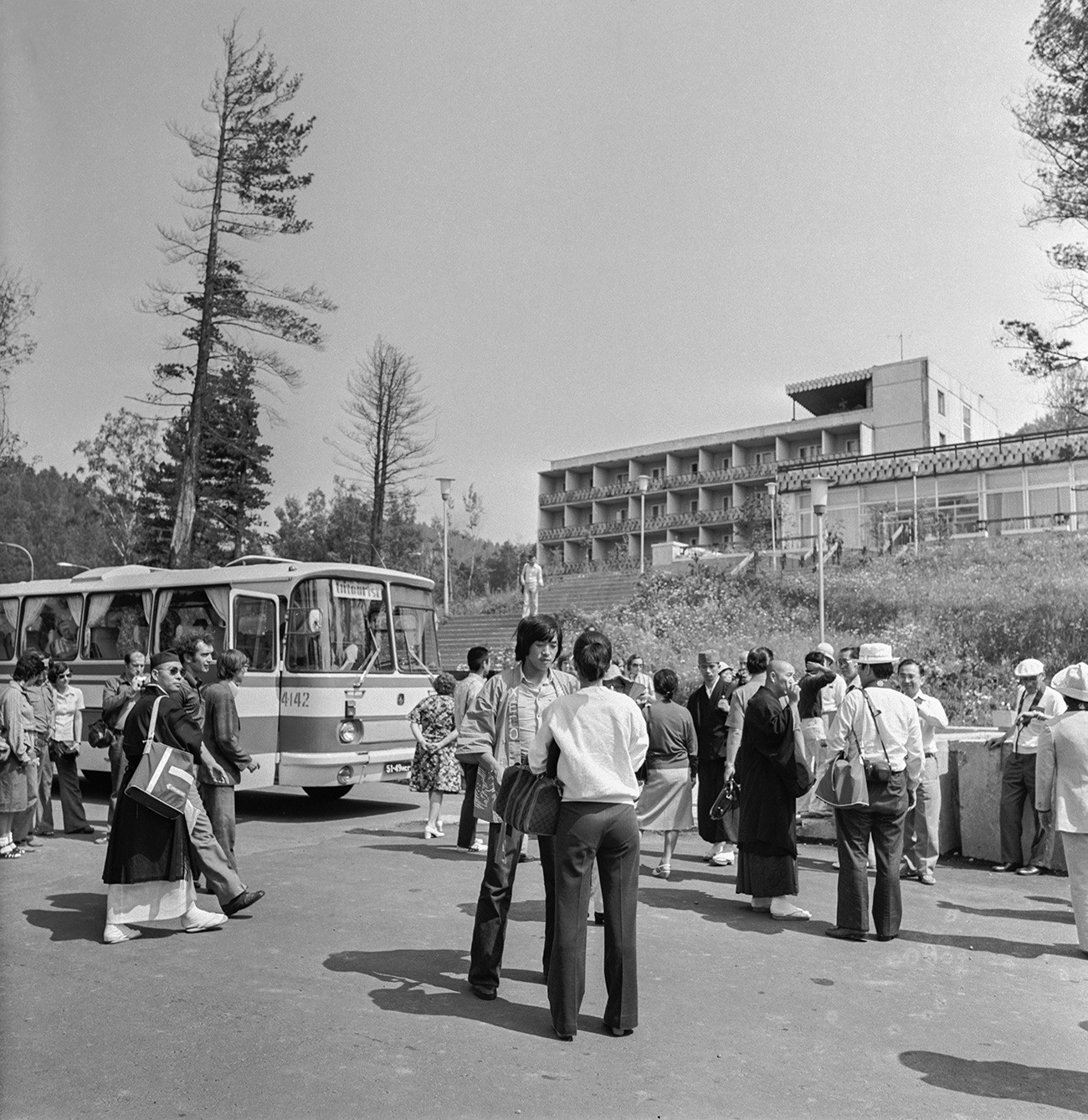
Japanese tourists during a trip to Lake Baikal, 1980
A former Intourist guide who worked for the company in the 1970-80s anonymously told Russian media that there were cases when young foreigners would sell Western items to Soviet citizens and then not know what to do with the rubles.
“Once, during a trip on the Trans-Siberian Railway, a group of students from the USA met a group of conscripts on the train and swapped clothes with them. The poor officer in charge of the conscripts was running up and down the train in search of an interpreter to make a reverse swap, and then locked his soldiers in a compartment so that they would not communicate with the tourists again.”

Foreign tourists visiting the museum of wooden architecture in Kizhi, 1972
What were tourists shown?
As a rule, foreign tourists' trips to the Soviet Union started in Moscow or Leningrad, which had the country's biggest airports. The rest depended on the type of the trip they had chosen.
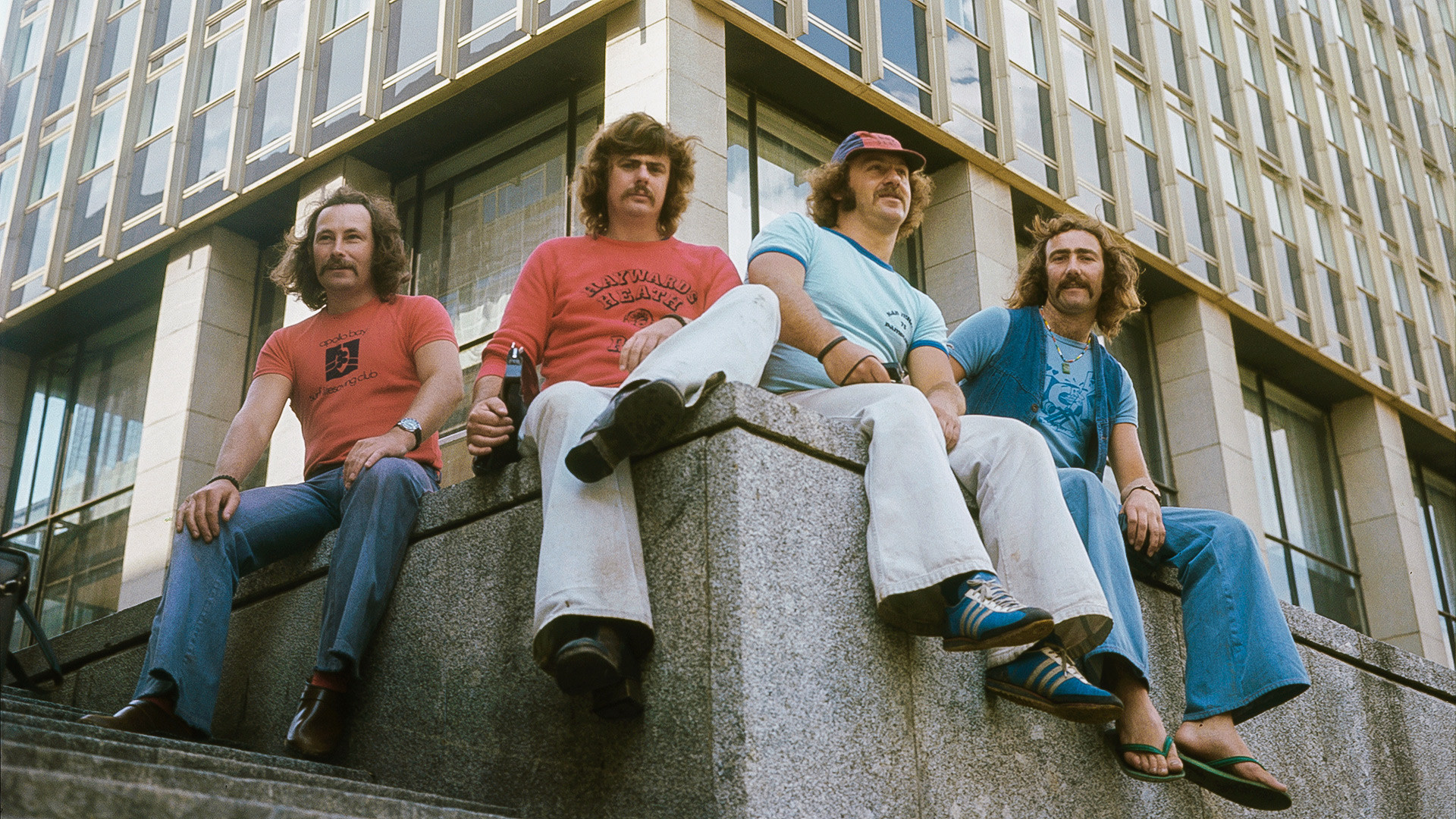
British tourists in Moscow (the Intourist hotel in the background), 1976
In the summer, Black Sea resorts were popular destinations. According to the TASS news agency, Crimea received some 4 million holidaymakers, including 30,600 foreign tourists from 40 countries, in 1968. The largest number of foreign visitors (8,200 people) came from West Germany, followed by the GDR (4,400), Czechoslovakia (3,500), Italy (3,100), and the United States (2,800). Two-thirds of foreign tourists arrived on cruise ships.
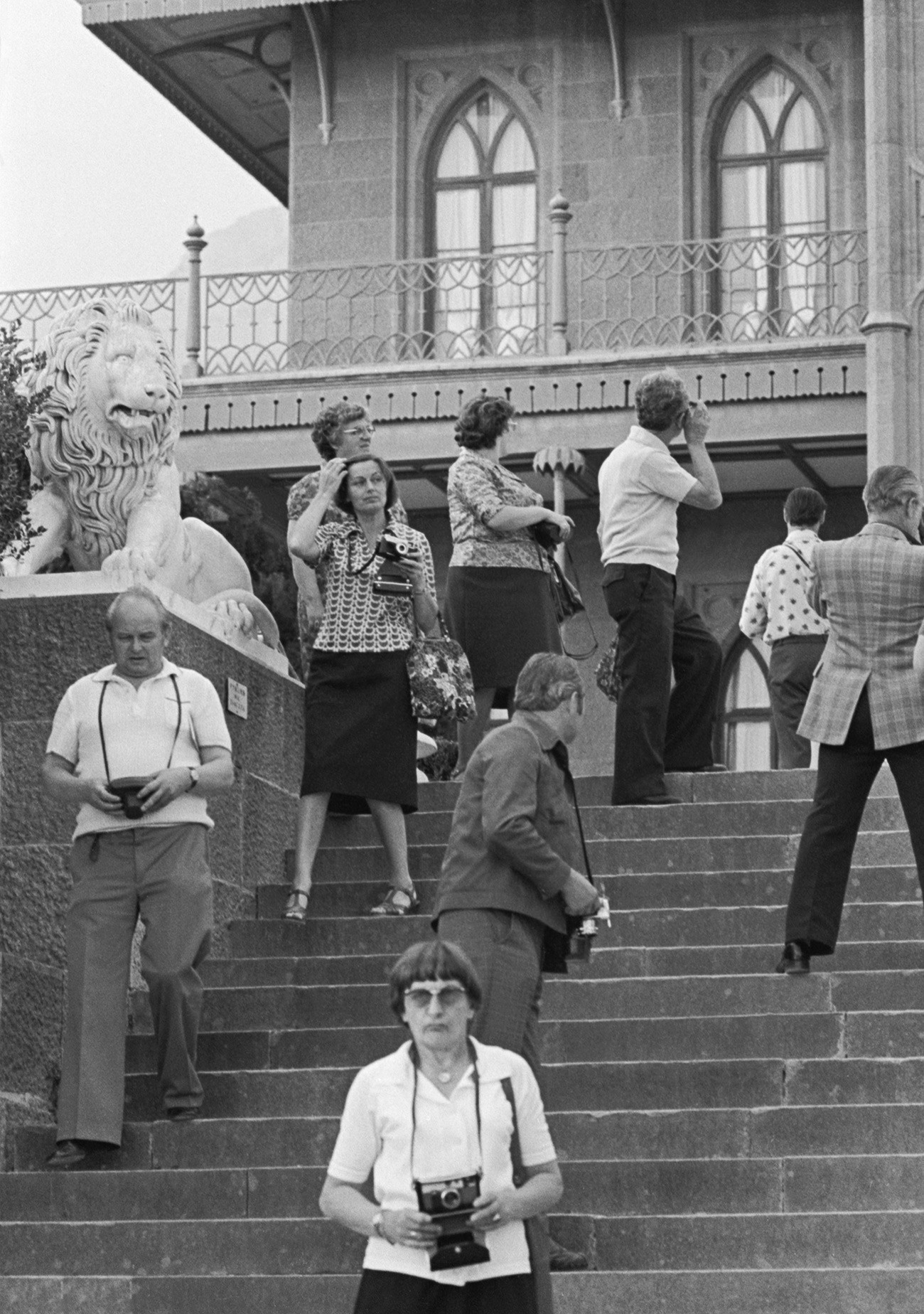
A group of tourists from the GDR in Alupka, Crimea. 1977
If foreign tourists visited the USSR in May or November, they were invariably taken to the demonstrations on May 1 or November 7.
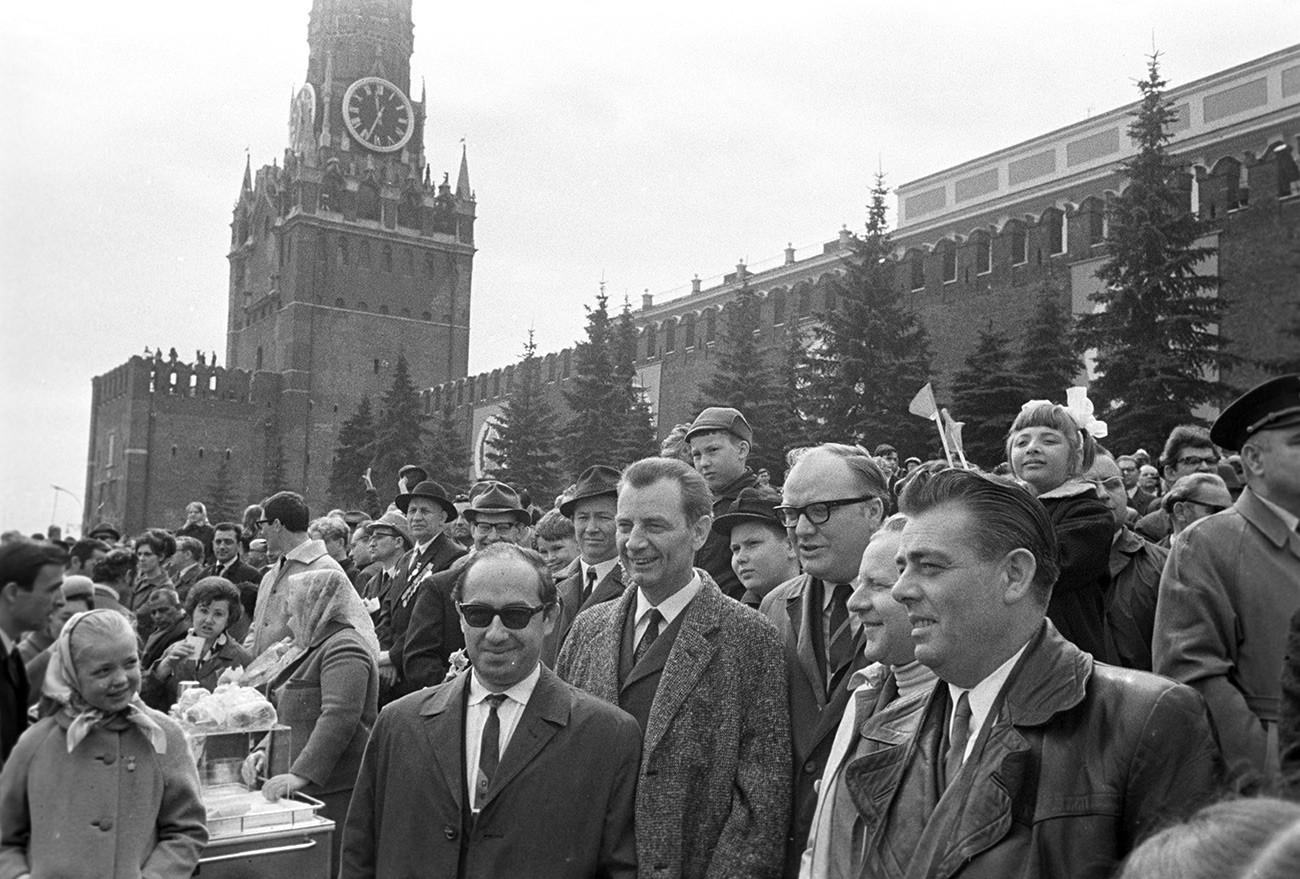
Foreign tourists during a demonstration in Red Square. May 1, 1970.
Young fighters on the ideological front
Students and working youth, especially from socialist countries (East Germany, Czechoslovakia, Yugoslavia, Cuba), made for one notable special category of tourists. In 1959, an international camp called Sputnik opened in Gurzuf (Crimea) where foreigners and Soviet citizens aged 18-35 could spend their vacations. By the end of the 1970s, 180,000 tourists, including 70,000 foreigners, had visited the camp.
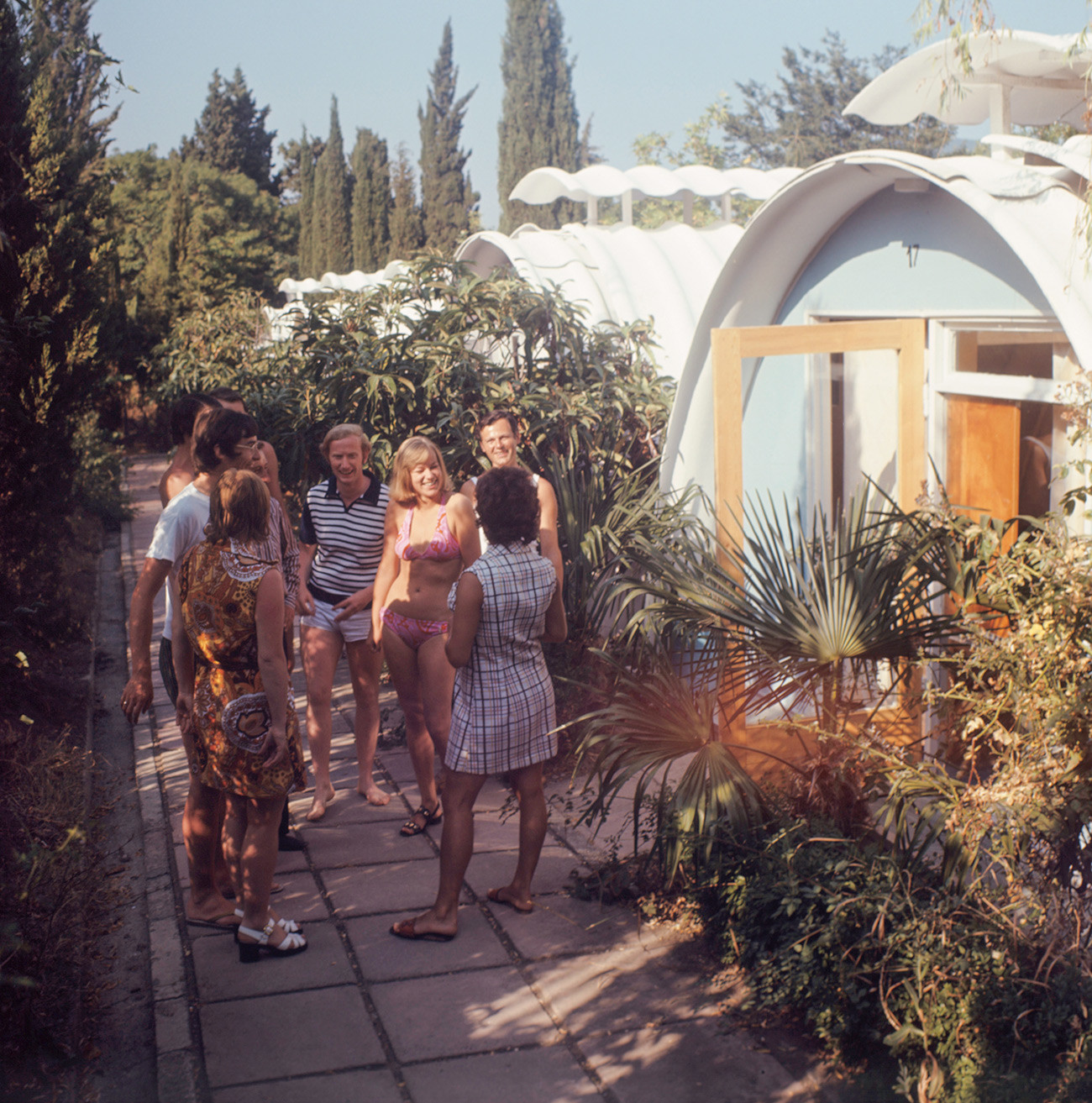
Young people from Leipzig, Germany, photographed at the Sputnik youth camp.
Camps like these held a huge number of interesting events, ranging from meetings with Soviet athletes to discussions on global topics like disarmament. They also organized national days and, without fail, so-called “peace campfires.” Generally speaking, the focus was always on friendship between different countries and peoples. And, of course, there were excursions, hikes, and various sports competitions.
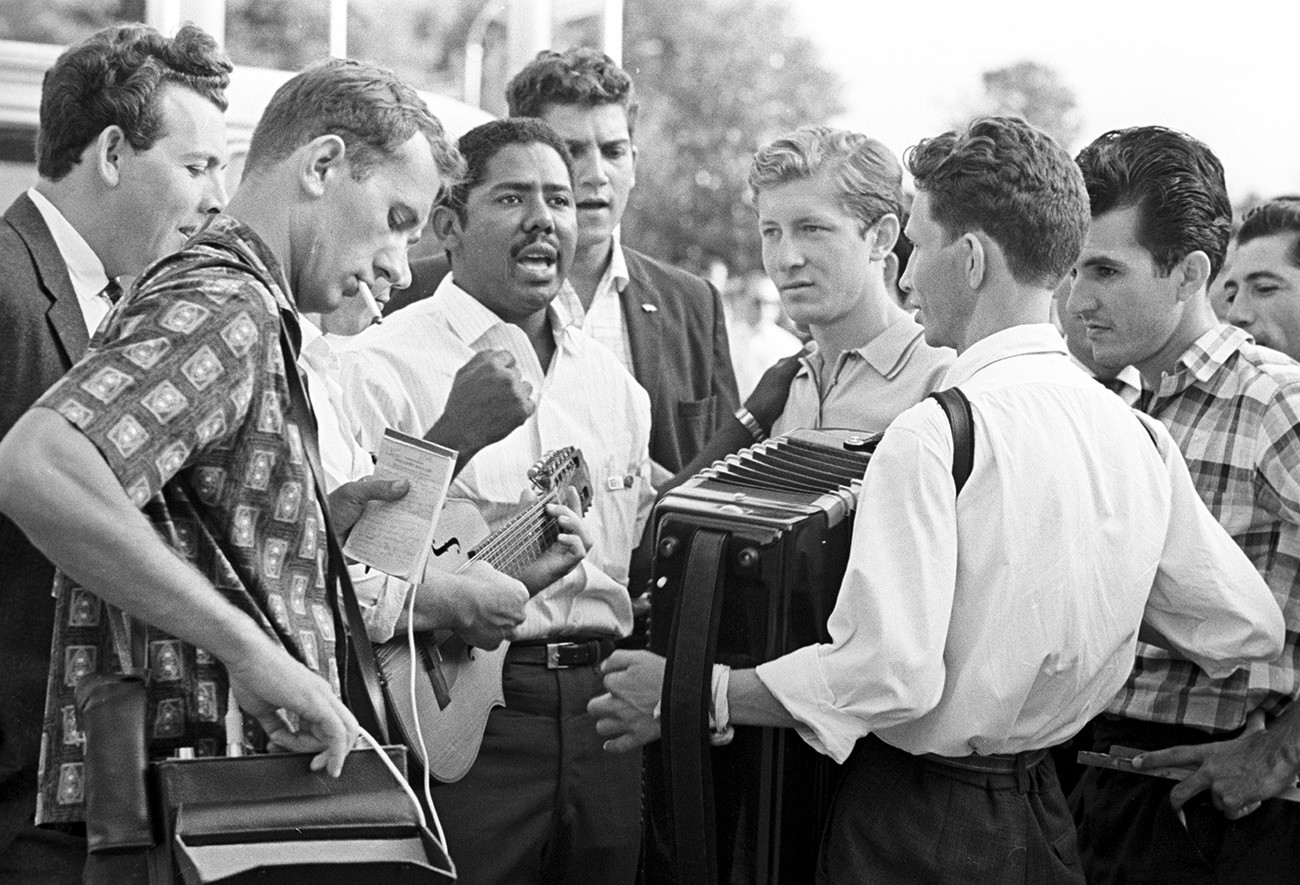
A Cuban youth delegation at the Sputnik international camp.
Not surprisingly, spots at Sputnik were allocated only to “ideologically fit” Soviet students and the best-performing workers. However, the camp administration noted in their reports that in the end vacationers all the same "showed political apathy, an inclination to informal communication with foreigners, spending all their time on the beach and a dissipated lifestyle.”
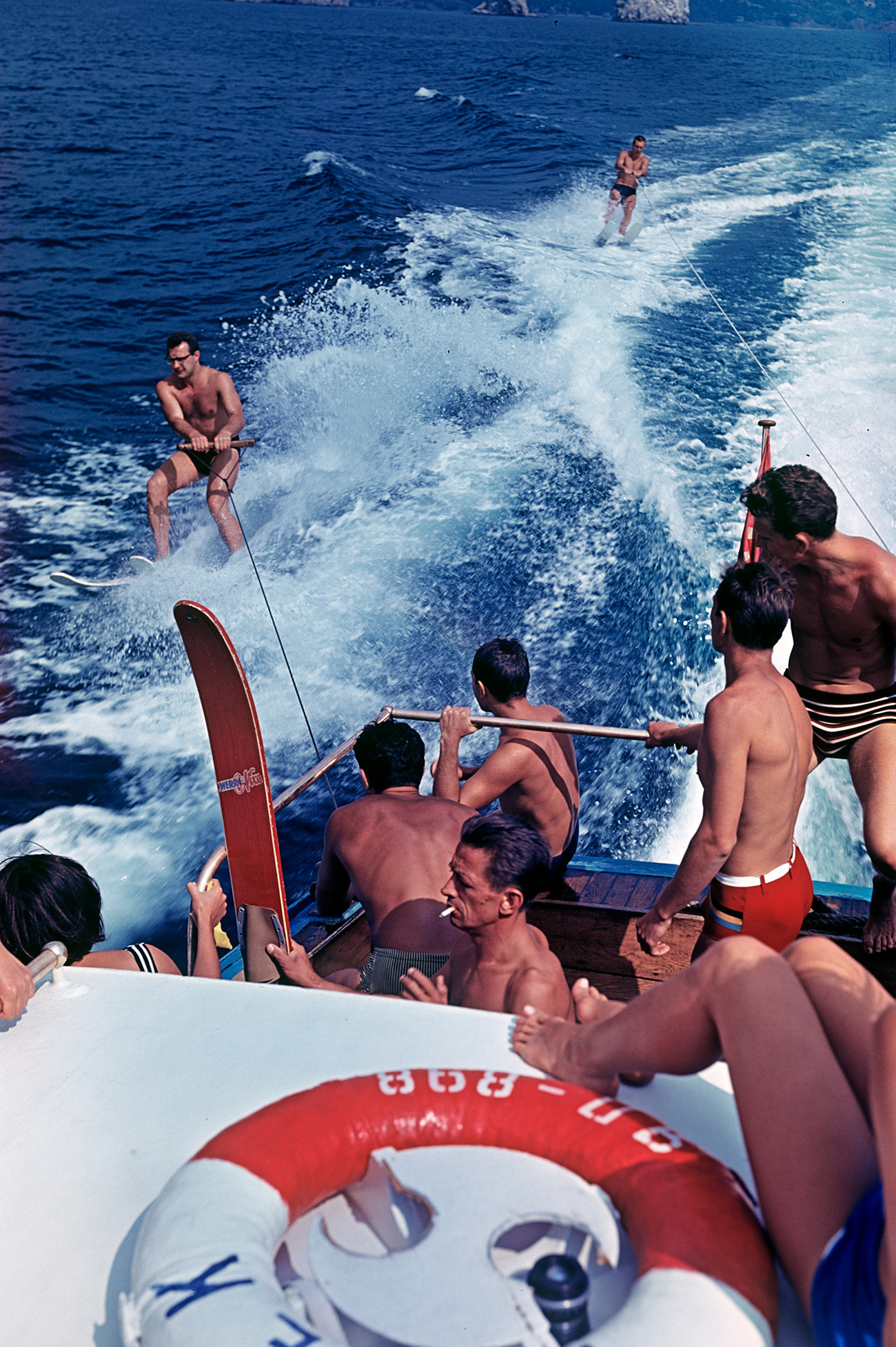
Water skiing, a popular leisure activity at the Sputnik international camp in Gurzuf, Crimea
If using any of Russia Beyond's content, partly or in full, always provide an active hyperlink to the original material.
to our newsletter!
Get the week's best stories straight to your inbox
This website uses cookies. Click here to find out more.
Mao, Khrushchev, and the Moscow Conference, 1957
- First Online: 01 November 2019
Cite this chapter

- Zhihua Shen 2
Part of the book series: China Connections ((CC))
975 Accesses
This chapter discusses the 1957 Moscow Conference of World Communist and Workers’ Parties. The idea of convening a conference and issuing a joint declaration was proposed by both the Chinese Communist Party (CCP) and the Communist Party of the Soviet Union (CPSU). During the conference, Mao played an important and unique role. However, Mao’s extemporaneous remarks at the conference shocked the Kremlin. His comments on the Soviet intra-party struggle, his outrageous comments on nuclear war, and his declaration that China would overtake Great Britain in 15 years created doubts and dissatisfaction in the minds of the delegates and cast a cloud over the conference. The Moscow Declaration revealed the Sino-Soviet disagreement, especially Beijing’s challenge to Soviet leadership of the socialist bloc. Thus, the Moscow Conference was a historical turning point in the Sino-Soviet relationship.
This is a preview of subscription content, log in via an institution to check access.
Access this chapter
- Available as PDF
- Read on any device
- Instant download
- Own it forever
- Available as EPUB and PDF
- Compact, lightweight edition
- Dispatched in 3 to 5 business days
- Free shipping worldwide - see info
- Durable hardcover edition
Tax calculation will be finalised at checkout
Purchases are for personal use only
Institutional subscriptions
Of the 68 parties that attended the conference, 4 (including the American Communist Party) made no public appearance for fear of persecution back home. Although 81 parties attended the Moscow Conference in November 1960, Mao Zedong was not present because of growing tensions with Moscow. Soviet and Chinese officials at the 1960 meeting could present only a facade of unity to the outside world. Hence, the 1960 Moscow Conference cannot be compared to the 1957 conference.
This view has been continuously recycled in the Chinese literature. See Lüthi, The Sino-Soviet Split , p. 75.
The Sino-Soviet relationship was at its friendliest stage (the “honeymoon period”) from October 1954 to late 1957. This periodization differs from the traditional view in Chinese academic circles.
Stalin proposed the idea of convening a meeting of the Cominform in early 1951 and designated Italian Communist Party General Secretary Palmiro Togliatti as general secretary. But Togliatti declined, and no such conference was ever held.
Goncharov, Lewis, and Xue, Uncertain Partners, Stalin , pp. 71–73, 232–33; for a recent study on the Asian Cominform, see Zhihua Shen and Yafeng Xia, “Leadership Transfer in the Asian Revolution: Mao Zedong and the Asian Cominform,” Cold War History , vol. 14, no. 2 (May 2014), pp. 195–214.
The Chinese Foreign Ministry reported that China’s role in Soviet foreign relations became much more important after the Polish and Hungarian crises. The USSR adopted “a series of new approaches to strengthen Sino-Soviet friendship.”
Mićunović, Moscow Diary , p. 294.
Hu Qiaomu had been Mao’s political secretary since 1941 and was at that time director of China’s Information Agency and deputy head of the CCP Propaganda Department. He was also the chief drafter of many important CCP documents.
For a detailed discussion of these three points, see Shen and Xia, Mao and the Sino-Soviet Partnership , pp. 249–62.
The CCP opposed the following wording in the draft declaration: “The TwentiethCPSU Congress creatively developed Marxism. The EighthCCP Congress and the Congresses of the French Communist Party and the Italian Communist Party also showed loyalty to Marxism.” The CCP insisted it was unnecessary to mention the Eighth CCP Congress. The congress of an individual party was its own business and required no approval by the international conference.
At the Moscow Conference in November 1960, the most controversial issue between the CCP and the CPSU was whether to mention the TwentiethCPSU Congress in the conference declaration.
Mićunović, Moscow Diary , pp. 191–92.
Khrushchev, Khrushchev Remembers , p. 254. According to reports from the Chinese embassy in the USSR, the formulation “the socialist camp under the leadership of the USSR and China” first appeared in the USSR in February 1955 after Khrushchev’s visit to China in February 1954.
Gomułka pointed out in his speech at the plenary session on 17 November that to recognize “the USSR as the head” was simply recognizing the historical reality.
Khrushchev, Khrushchev Remembers , p. 254.
Later, during the Sino-Soviet polemics, the CCP CC argued that the reference to Moscow’s leadership role “means only that the CPSU undertakes more responsibilities and obligations.”
Edvard Kardelj, Reminiscences: The Struggle for Recognition and Independence in the New Yugoslavia, 1944–1957 (London: Blond and Briggs, with Summerfield Press, 1982); Mićunović, Moscow Diary , pp. 314–18.
On 31 January 1958, Soviet leaders asked for Beijing’s views on the prospect of starting a theoretical journal for the International Communist Movement. The CPSU suggested that the journal be a joint publication of all parties to publicize Marxism-Leninism and to exchange experiences. The CCP concurred. The resulting journal, Problems of Peace and Socialism , was published in Prague in 34 languages from 1958 to 1991 and distributed to 145 countries.
The International Communist Movement subsequently held several conferences to try to resolve the problems. Major conferences included the December 1960 Moscow Conference, the March 1965 Moscow Conference, and the June 1969 Moscow Conference.
In a reflection of Mao’s attention to the conference, the Chinese side prepared 396 separate gifts for Mao to take to the USSR. The gifts for the Soviet leaders occupied almost an entire railway car.
Song Qingling was the widow of Sun Yatsen, the founding father of modern China. She was then a vice-president of the PRC.
Mao explained that he once suffered from cerebral anemia and he felt great discomfort when speaking while standing.
On Mao’s 18 November speech, see Shen and Xia, Sino-Soviet Partnership , pp. 263–70.
Medvedev, Khrushchev , pp. 115–16.
Khrushchev, Khrushchev Remembers , p. 255.
Vremya i my (Tel Aviv), no. 48 (1979), pp. 164–65, quoted in Medvedev, Khrushchev , p. 122.

Author information
Authors and affiliations.
East China Normal University, Shanghai, China
Zhihua Shen
You can also search for this author in PubMed Google Scholar
Corresponding author
Correspondence to Zhihua Shen .
Editor information
Editors and affiliations, rights and permissions.
Reprints and permissions
Copyright information
© 2020 The Author(s)
About this chapter
Shen, Z. (2020). Mao, Khrushchev, and the Moscow Conference, 1957. In: Shen, Z. (eds) A Short History of Sino-Soviet Relations, 1917–1991. China Connections. Palgrave Macmillan, Singapore. https://doi.org/10.1007/978-981-13-8641-1_13
Download citation
DOI : https://doi.org/10.1007/978-981-13-8641-1_13
Published : 01 November 2019
Publisher Name : Palgrave Macmillan, Singapore
Print ISBN : 978-981-13-8640-4
Online ISBN : 978-981-13-8641-1
eBook Packages : Social Sciences Social Sciences (R0)
Share this chapter
Anyone you share the following link with will be able to read this content:
Sorry, a shareable link is not currently available for this article.
Provided by the Springer Nature SharedIt content-sharing initiative
- Publish with us
Policies and ethics
- Find a journal
- Track your research
Black Hills Highway Closure to Upend Summer Holiday Traffic
A section of the only north-south highway through the central Black Hills has closed for construction through July 12, cutting off a major transportation and tourism pipeline in the area
PACTOLA RESERVOIR, S.D. (AP) — Angie Weaver, who co-owns the Pactola Marina in the Black Hills, remains hopeful that the full closure of U.S. 385 won’t sink her summer revenues that are critical to remaining profitable for the entire year.
U.S. 385 is the only north-south highway through the central Black Hills and the only route people can take to get to Pactola Reservoir and the marina.
“It’s going to be a weird year for us, and I’m looking forward to it being over,” Weaver said. “All we can do at this point is let customers know about the construction and hope for the best.”
The full closure of the highway just north of the reservoir began on May 19 and will remain closed until July 12, messing up traffic in the tourism-dominated region over both the Memorial Day and July 4 holidays.
The South Dakota Department of Transportation has embarked on a $72 million project to rebuild 15 miles of the highway, which is a scenic drive but one that also has a high rate of crashes and fatalities.
The closure will disrupt any motorist driving between Hill City on the south and the Lead-Deadwood area on the north. The hour-long, more than 50-mile official detour will require people to drive through Rapid City to get around the highway closure near Pactola.
The two-lane highway provides access to Pactola Reservoir and Sheridan Lake. The road is also a pipeline to Mount Rushmore National Memorial and Crazy Horse Memorial and helps fuel a regional tourism industry that brought $2 billion in revenue to South Dakota in 2021.
In all, the project will include five separate complete closures of the winding two-lane highway that flows amid scenic lakes, rock outcroppings and dramatic ridges.
“This construction goes through 2027, so it’s gonna be a long process,” Weaver said. “But this year, for us, is going to be the biggest year in terms of affecting our business.”
Like other business owners in the Black Hills, Weaver and marina partner Dan Fisher have tried to get ahead of the road closure to keep customers happy and coming back.
The pair rents boats and kayaks, sells snacks and supplies and has 200 boat slip rentals, about half of which are on the north side of the reservoir where the entrance road will be closed for a while in May and June. During that time, they have agreed to use a boat to ferry people from the south marina to the north marina so slip renters can still access their boats.
Weaver was heartened to see a solid pre-booking of boat rentals for the Independence Day holiday, typically her busiest time of the summer, despite the fact U.S. 385 will be completely closed during that period.
“That’s a whole month-and-a-half that our renters have to drive an extra hour to get to us,” she said, adding they have posted notice of the pending road closure on their website and in confirmation emails sent to renters.
The South Dakota Department of Transportation issued a press release on May 13 that spelled out the closure time frames and stated that while the road will be fully blocked, temporary access to the Pactola north boat ramp will be available on weekends and on Memorial Day.
The overall construction project will include widening road shoulders, smoothing out sharp curves and adding turn lanes to make the road safer. In the five-year period from 2018-2022, 187 crashes were reported in the area now under construction, with four fatalities and 57 injuries. A third of those wrecks and most of the deaths occurred when motorists left the roadway, which in spots is flanked by deep ravines or craggy rocks.
DOT plans to clear trees, blast rock, enact lane closures with use of pilot cars and close the highway completely at five separate locations for up to months at a time. Tree-clearing began in November and in recent weeks, a 15-minute pilot car delay has been in place north of Highway 44. The state will open the road fully during certain high-traffic times, including for the Sturgis rally in August.
The state has created a website to provide project information and updates. Prior to the start of the project, DOT officials held a series of public meetings to inform the public about the need for the construction.
“Complete closures were deemed necessary for the safety of the traveling public and efficiency of the project due to the large amount of material being blasted and moved throughout the closure areas,” DOT said in its May 13 release.
However, Weaver and some other business owners have told News Watch that they weren’t fully satisfied with the DOT’s approach to the project and an overall unwillingness to listen to ideas or accommodate the needs of residents.
“There’s a group of us small business owners in the area that also had a meeting with them, and it felt more like an informative meeting,” she said. “Instead of a, ‘Hey, what are some suggestions,’ approach, and ‘What do you guys need from us,’ there was none of that.”
But Weaver insisted that in the end, it will all be worth it to have a safer highway through the scenic central Black Hills region.
“It’s going to be a great road, and I know they’re going to do a really great job,” she said.
Pennington County Sheriff Lt. David Switzer told News Watch that his agency is working closely with the state local fire departments, the Highway Patrol, and the Game, Fish and Parks Department to coordinate emergency response efforts during the highway closures.
“We’re aware that when there are pilot cars running up there or a full closure, there’s going to be significant delays,” he said.
The sheriff’s office has realigned its patrol “beats” and will have more deputies in the area to respond efficiently to incidents to emergencies on both sides of the road closure, Switzer said.
“There’s going to be a point where they’re going to break up the road because they have to remove a big chunk of it, so you have to adjust your resources to respond to that,” he said.
In advance of the full closure of U.S. 385, authorities have posted a boat in a slip at the north Pactola marina to respond to lake emergencies more quickly by not having to trailer a rescue boat through a road closure or construction zone.
“If we have any emergency at the swim beach or the marina or any of the campgrounds close to the boat ramps, we’ll be able to quickly get to a boat there to respond,” said Switzer, who also serves with the nearby Johnson Siding Volunteer Fire Department.
Switzer’s big advice to motorists is to plan ahead, be patient and follow signage to avoid accidents or injuries.
“Don’t drive around road closure signs,” he said. “Follow the detours and be patient because the worst thing you can do is got stuck in a construction zone where there is no road.”
On a recent Sunday, Jeff Woods of Black Hawk secured his family’s boat at their rented slip at the Pactola Marina after going for one of their frequent joy rides.
Woods said the highway closure will cost him about 20 minutes in extra travel time to get to the marina via the southern detour. Woods said he will take Sheridan Lake Road on the south end and shave off distance from the official detour route that takes drivers on U.S. Highway 16 through Rapid City and then back to U.S. 385.
Woods said the road blockage will not stop his family from using their boat or visiting their nearby cabin as often as usual this summer.
“It makes it more of a hassle,” Woods said. “But it’s really just more of an annoyance than anything else.”
This story was originally published by South Dakota News Watch and distributed through a partnership with The Associated Press.
Copyright 2024 The Associated Press . All rights reserved. This material may not be published, broadcast, rewritten or redistributed.
Photos You Should See - May 2024

Join the Conversation
Tags: South Dakota , Associated Press , Transportation , traffic , business
Related Articles
America 2024

Best States

Best States Rankings
- # 2 New Hampshire
- # 3 Nebraska
- # 4 Minnesota
Health News Bulletin
Stay informed on the latest news on health and COVID-19 from the editors at U.S. News & World Report.
Sign in to manage your newsletters »
Sign up to receive the latest updates from U.S News & World Report and our trusted partners and sponsors. By clicking submit, you are agreeing to our Terms and Conditions & Privacy Policy .
You May Also Like
The 10 best states in america.
Elliott Davis Jr. May 7, 2024

Why Utah Is the Best State
Elliott Davis Jr. and Julia Haines May 7, 2024

Why Florida Is No. 1 in Education
Tim Smart May 7, 2024

Seattle Police Chief Dismissed From Top Job Amid Discrimination, Harassment Lawsuits
Associated Press May 29, 2024

Republican Blocks Confirmation of First Native American Federal Judge for Montana

At Sen. Bob Menendez's Bribery Trial, Prosecutors Highlight His Wife's Desperate Finances

Elizabeth Warren Warns of Efforts to Limit Abortion in States That Have Protected Access

Texas Democrat Who Joined GOP in Supporting Ban on Gender-Affirming Care for Minors Loses Primary

Massachusetts Fugitive Dubbed the 'Bad Breath Rapist' Captured in California After 16 Years at Large

Election Board Member in Georgia's Fulton County Abstains From Certifying Primary Election


- Search our Publications
- Current Projects
- Recruitment
- Legislation Directory
- Classified List of Legislation
Revised Acts
- You are here:
- Introduction
- Alphabetical List
- Chronological List
Annotations
Latest News and Publications
Open competition for appointment to the position of: Deputy Director of Research
Attorney General Rossa Fanning S.C. remarks at Launch of Report on 'A Regulatory Framework for Adult Safeguarding
The Law Reform Commission Publishes Report on A Regulatory Framework for Adult Safeguarding
Tourist Traffic Act 1939
- Act by Section
- Act As Enacted
- PDF annotated
- PDF unannotated
- First Section 〉
Number 24 of 1939
TOURIST TRAFFIC ACT 1939
Updated to 16 September 2020
Changes to legislation: as of 7 May 2024, this Act is up to date with all changes known to be in force.
This Revised Act is an administrative consolidation of the Tourist Traffic Act 1939 . It is prepared by the Law Reform Commission in accordance with its function under the Law Reform Commission Act 1975 (3/1975) to keep the law under review and to undertake revision and consolidation of statute law.
All Acts up to and including the Criminal Justice (Enforcement Powers) (Covid-19) Act 2020 (14/2020), enacted 11 September 2020, and all statutory instruments up to and including the Tourism and Sport (Transfer of Departmental Administration and Ministerial Functions) Order 2020 (S.I. No. 356 of 2020), made 15 September 2020, were considered in the preparation of this Revised Act.
Disclaimer: While every care has been taken in the preparation of this Revised Act, the Law Reform Commission can assume no responsibility for and give no guarantees, undertakings or warranties concerning the accuracy, completeness or up to date nature of the information provided and does not accept any liability whatsoever arising from any errors or omissions. Please notify any errors, omissions and comments by email to
ARRANGEMENT OF SECTIONS
Preliminary and General.
Establishment and General Powers of the Irish Tourist Board.
Registration of Premises.
Establishment of Special Areas.
Amendment of the Tourist Traffic (Development) Act , 1931.
AN ACT TO MAKE FURTHER AND BETTER PROVISION FOR THE ENCOURAGEMENT AND DEVELOPMENT OF THE TOURIST TRAFFIC, AND FOR THAT PURPOSE TO ESTABLISH A BOARD HAVING POWERS OF REGULATION, REGISTRATION, AND CONTROL IN MATTERS RELATING TO THE TOURIST TRAFFIC AND, IN PARTICULAR, THE ACCOMMODATION AND ATTRACTIONS AVAILABLE FOR TOURISTS, AND TO PROVIDE FOR THE CHARGING OF FEES BY SUCH BOARD IN RESPECT OF REGISTERS KEPT BY THEM, AND TO PROVIDE FOR DIVERS MATTERS ANCILLARY TO OR CONNECTED WITH THE MATTERS AFORESAID. [27 th July , 1939.]
BE IT ENACTED BY THE OIREACHTAS AS FOLLOWS:—
Modifications (not altering text):
Functions transferred and references to “Department of Transport, Tourism and Sport” and “Minister for Transport, Tourism and Sport” in collectively cited Tourist Traffic Acts construed (16.09.2020) by Tourism and Sport (Transfer of Departmental Administration and Ministerial Functions) Order 2020 (S.I. No. 356 of 2020), arts. 2 and 3, in effect as per art. 1(2), subject to transitional provisions in arts. 4-8.
Note change of name of Department and Minister to Tourism, Culture, Arts, Gaeltacht, Sport and Media (30.09 2020) by Culture, Heritage and the Gaeltacht (Alteration of Name of Department and Title of Minister) Order 2020 (S.I. No. 403 of 2020), in effect as per art. 1(2).
2. (1) The administration and business in connection with the exercise, performance or execution of any functions transferred by Article 3 are transferred to the Department of Culture, Heritage and the Gaeltacht.
(2) References to the Department of Transport, Tourism and Sport contained in any Act or any instrument made under such Act and relating to any administration and business transferred by paragraph (1) shall, from the commencement of this Order, be construed as references to the Department of Culture, Heritage and the Gaeltacht.
3. (1) The functions vested in the Minister for Transport, Tourism and Sport by or under —
( a ) the Tourist Traffic Acts 1939 to 2016,
are transferred to the Minister for Culture, Heritage and the Gaeltacht.
(2) References to the Minister for Transport, Tourism and Sport contained in any Act or instrument made under such Act and relating to any functions transferred by this Order shall, from the commencement of this Order, be construed as references to the Minister for Culture, Heritage and the Gaeltacht.
Editorial Notes:
Previous affecting provision: functions transferred and references to “Department of Tourism, Culture and Sport” and “Minister for Tourism, Culture and Sport” construed (1.04.2011) by Tourism and Sport (Transfer of Departmental Administration and Ministerial Functions) Order 2011 (S.I. No. 140 of 2011), arts. 2 and 3, in effect as per art. 1(2); superseded as per C-note above.
Previous affecting provision: functions transferred and references to “Department of Tourism, Transport and Communications” and “Minister for Tourism, Transport and Communications” construed (20.01.1993) by Tourism (Transfer of Departmental Administration and Ministerial Functions) Order 1993 (S.I. No. 15 of 1993), arts. 3 and 4, commenced on enactment; superseded as per C-note above.
Previous affecting provision: functions transferred and references to “Department of the Marine” and “Minister for the Marine” construed (31.03.1987) by Tourism (Transfer of Departmental Administration and Ministerial Functions) Order 1987 (S.I. No. 95 of 1987), arts. 3 and 4, in effect as per art. 1(2); superseded as per C-note above.
Previous affecting provision: functions transferred and references to “Department of Industry, Trade, Commerce and Tourism” and “Minister for Industry, Trade, Commerce and Tourism” construed (18.02.1986) by Tourism (Transfer of Departmental Administration and Ministerial Functions) Order 1986 (S.I. No. 42 of 1986), arts. 3 and 4, in effect as per art. 1(2); superseded as per C-note above.
Previous affecting provision: functions transferred and references to “Department of Tourism and Transport” and “Minister for Tourism and Transport” construed (24.01.1980) by Tourism (Transfer of Departmental Administration and Ministerial Functions) Order 1980 (S.I. No. 8 of 1980), arts. 3 and 4, in effect as per art. 1(2); superseded as per C-note above.
Previous affecting provision: functions transferred and references to “Department of Industry and Commerce” and “Minister for Industry and Commerce” construed (31.10.1961) by Transport, Fuel and Power (Transfer of Departmental Administration and Ministerial Functions) (No. 2) Order 1961 (S.I. No. 246 of 1961), arts. 3 and 4, commenced on enactment; superseded as per C-note above.

IMAGES
VIDEO
COMMENTS
an act to amend the tourist traffic acts, 1939 to 1955. [17th december, 1957.]. be it enacted by the oireachtas as follows:—
AN ACT TO AMEND THE TOURIST TRAFFIC ACTS, 1939 TO 1955. [17th December, 1957.]. BE IT ENACTED BY THE OIREACHTAS AS FOLLOWS:— Construction. 1.—(1) In this Act— "the Act of 1939" means the Tourist Traffic Act, 1939 (No. 24 of 1939); "the Act of 1952" means the Tourist Traffic Act, 1952 (No. 15 of 1952); "the Board" means Bord Fáilte Éireann;
This Revised Act is an administrative consolidation of the Tourist Traffic Act 1957.It is prepared by the Law Reform Commission in accordance with its function under the Law Reform Commission Act 1975 (3/1975) to keep the law under review and to undertake revision and consolidation of statute law.. All Acts up to and including the Criminal Justice (Enforcement Powers) (Covid-19) Act 2020 (14/ ...
This Revised Act is an administrative consolidation of the Tourist Traffic Act 1957.It is prepared by the Law Reform Commission in accordance with its function under the Law Reform Commission Act 1975 (3/1975) to keep the law under review and to undertake revision and consolidation of statute law.. All Acts up to and including the Criminal Justice (Enforcement Powers) (Covid-19) Act 2020 (14/ ...
Tourist Traffic Act , 1957 (Act 27 of 1957) Tourist Traffic Bill, 1957 (Bill 27 of 1957) Share this page Bills & Acts; Find Bills & Acts ... Committee on Finance. - Tourist Traffic Bill, 1957—Report and Final Stages. View debate 4 Dec 1957. Dáil Éireann Committee on Finance. ...
Tourist Traffic Act 1957 . Full Act; Act by Section; Act As Enacted; Amendments; PDF annotated; PDF unannotated; Go to Front; ... (28.05.2003, establishment day) by National Tourism Development Authority Act 2003 (10/2003), s. 12(1)-(5) and sch. 2, subject to transitional provision in s. 38, effectively commenced by Establishment Day Order S.I ...
1.— (1) In this Act— "the Act of 1939" means the Tourist Traffic Act, 1939 (No. 24 of 1939); "the Act of 1952" means the Tourist Traffic Act, 1952 (No. 15 of 1952); "the Board" means Bord Fáilte Éireann; "the Minister" means the Minister for Industry and Commerce. (2) The Tourist Traffic Acts, 1939 to 1955, and this Act shall be construed as one.
AN ACT TO AMEND THE TOURIST TRAFFIC ACTS, 1939 TO 1955. [17th December, 1957.]. BE IT ENACTED BY THE OIREACHTAS AS FOLLOWS:— Construction. 1.—(1) In this Act— "the Act of 1939" means the Tourist Traffic Act, 1939 (No. 24 of 1939); "the Act of 1952" means the Tourist Traffic Act, 1952 (No. 15 of 1952); "the Board" means Bord Fáilte Éireann;
The Tourist Traffic Acts 1939 to 1998 and this Act may be cited together as the Tourist Traffic Acts 1939 to 2003, and shall be construed together as one Act. Interpretation. [s.2: 10/2003] (1) (1) In this Act, except where the context otherwise requires—. ''Authority'' has the meaning assigned to it by section 7 [paragraph 131];
"the Act of 1939" means the Tourist Traffic Act, 1939 (No. 24 of 1939); "the Act of 1952" means the Tourist Traffic Act, 1952 (No. 15 of 1952); "the Board" means Bord Fáilte Éireann; "the Minister" means the Minister for Industry and Commerce. (2) The Tourist Traffic Acts, 1939 to 1955, and this Act shall be construed as one.
AN BELLE UM THRACHT CUARTAIOCHTA, 1957. TOURIST TRAFFIC BELL, 1957. BILL entitled AN ACT TO AMEND THE TOURIST TRAFFIC ACTS, 5 1939 TO 1955. BE IT ENACTED BY THE OIREACHTAS AS FOLLOWS 1.—(1) In this Act— " the Act of 1939 " means the Tourist Traffic Act, 1939 (No. 24 of 1939); 10 " the Act of 1952 " means the Tourist Traffic Act ...
11.— (1) This Act may be cited as the Tourist Traffic Act, 1957. (2) The Tourist Traffic Acts, 1939 to 1955, and this Act may be cited together as the Tourist Traffic Acts, 1939 to 1957.
An International Meeting of Communist and Workers Parties was held in Moscow, Soviet Union, November 16-19, 1957. The meeting was attended by 64 political parties from all over the world. The meeting was the first of its kind, marking a new form of forum for the world communist movement following the disbanding of the Communist International (Comintern) and the Information Bureau of the ...
Intourist buses at the Palace Square, Leningrad, 1980. Intourist (Russian: Интурист, a contraction of иностранный турист, "foreign tourist") was a Soviet then Russian tour operator, headquartered in Moscow. It was founded on April 12, 1929, and served as the primary travel agency for foreign tourists in the Soviet Union.It was privatized in 1992 and, from 2011, was 50. ...
Intourist poster, 1930. Kirill Kallinikov/Sputnik. Some of the first foreigners to visit the Soviet Union were famous writers, artists and other public figures. Theodore Dreiser came in 1927 ...
Application of Pt. IV (ss. 25-32) extended (17.12.1957) by Tourist Traffic Act 1957 (27/1957), s. 8, commenced on enactment. Extension of references to premises. 8. —In Part III of the Act of 1939 and Part IV of the Act of 1952, any reference to premises shall, in a case in which there is both a main building used or intended to be used to ...
Abstract. This chapter discusses the 1957 Moscow Conference of World Communist and Workers' Parties. The idea of convening a conference and issuing a joint declaration was proposed by both the Chinese Communist Party (CCP) and the Communist Party of the Soviet Union (CPSU). During the conference, Mao played an important and unique role.
May 28, 2024, at 12:26 p.m. Black Hills Highway Closure to Upend Summer Holiday Traffic. More. PACTOLA RESERVOIR, S.D. (AP) — Angie Weaver, who co-owns the Pactola Marina in the Black Hills ...
AN BELLE UM THRACHT CUARTAIOCHTA, 1957. TOURIST TRAFFIC BILL, 1957. BILL entitled AN ACT TO AMEND THE TOURIST TRAFFIC ACTS, 5 1939 TO 1955. BE IT ENACTED BY THE OIREACHTAS AS FOLLOWS 1.—(1) In this Act— " the Act of 1939 " means the Tourist Traffic Act, of 1939); " the Act of 1952 " means the Tourist Traffic Act, of 1952);
This Revised Act is an administrative consolidation of the Tourist Traffic Act 1939.It is prepared by the Law Reform Commission in accordance with its function under the Law Reform Commission Act 1975 (3/1975) to keep the law under review and to undertake revision and consolidation of statute law.. All Acts up to and including the Criminal Justice (Enforcement Powers) (Covid-19) Act 2020 (14/ ...